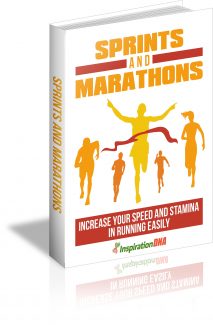 License Type: Master Resell Rights
License Type: Master Resell Rights  File Type: ZIP
File Type: ZIP
 SKU: 61548
SKU: 61548  Shipping: Online Download
Shipping: Online Download
Foreword
Running is the act by which animals, including human beings, move by the power of the feet. Speeds may vary and range from jogging to a sprint. A lot of individuals compete in track events that place participants in a contest to test speed in a sprint or endurance in a marathon. The running mechanics are the same, but additional factors are very different in a marathon versus a sprint.
Sprints And Marathons
Increase your speed and stamina in running easily.
Chapter 1:
The Basics
Sprints commonly are tested in track events including 100 m, 200 m or 400 m races. World-class athletes may finish these events in ten seconds, twenty seconds or forty-five seconds, respectively. A marathon is a race that's 26.2 miles long with world-class athletes completing the race in just over 2 hours.
Background
Scientific research has demonstrated that sprinters and marathoners have predominantly different muscle fiber types. Sprinters will have fast-twitch muscle fibers that create greater force and bear a faster contraction or response time. Marathoners have slow-twitch muscle fibers that create force slowly and remain contracted longer.
A big amount of calories and energy are burned during marathons, calling for a significant energy source. To meet this requirement, fat, carbohydrates and protein supply the majority of the energy. Sprinting uses ATP or glucose as energy, as the total amount of energy burned up is lower than in marathons.
Sprinting is an anaerobic activity that lets the muscles contract without oxygen. These anaerobic activities are characterized by short acute bursts of energy utilizing a big percentage of maximal strength. Marathons are an aerobic activity that calls for oxygen to be delivered to the muscles during contractions. Aerobic activities call for a lower level of physical exertion over a longer time period utilizing a lower percentage of maximal strength.
Both sprinting and marathons may provide a number of physical advantages, including weight loss, improved heart and cardiovascular health, expanded strength and endurance and increased bone density.
Running likewise may have positive effects on mental health, including treatment of depression or curing addictions.
Chapter 2:
Should You Sprint
Sprints are anaerobic, signifying they utilize a different sort of energy than long-distance aerobic actions, and always short. For a lot of individuals, sprints are simply plain fun.
It's exciting to go as fast as you are able to and not have to worry about maintaining the high level of effort for a long time. Sprinting likewise has a lot of applications for daily life, like running for the bus or chasing a toddler.
Although sprinting is a fantastic addition to your workout routine, it shouldn't be the only thing you do.
A Choice
Sprinting is all about speed. When you center your training routine on one specific element, like speed or strength or endurance, that separate element is going to improve. Integrating sprints into your workout repertoire will make you quicker in 5Ks, marathons, or on the soccer field. Naturally, you can't sustain a sprint pace during a longer run, but you ought to see a decrease in your longer-course times.
Sprinting solely won't help improve your endurance. If you wish to run both faster and longer, mix up your running routine: If you run 4 days a week, do sprints on 2 days and longer runs the other 2 days. Switching things around doubles your benefit and prevents tedium for mind and body.
A study discovered that sprint interval training bettered heart health just as well as traditional endurance training for healthy individuals.
When you exercise at a high intensity, the risk of injury likewise increases. In sprinting, likely injuries include tender muscles, muscle pulls and strains, ankle and knee stress traumas, back issues and, for some individuals, irregular heart rhythms after the exercise.
- License: Master Resell Rights
- Category:Ebooks
- Tags:2018 Ebooks Master Resale Rights








